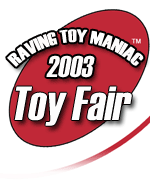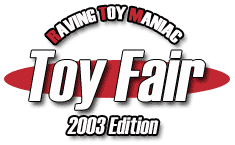





  |
 
|
 |
Hasbro: Magic: the Gathering
MAGIC: THE GATHERING 10th ANNIVERSARY FACT SHEET I. General Overview
II. The Game The basic structure of the Magic game is as follows:
- The MAGIC: THE GATHERING trading card game (TCG) made its debut in August 1993. Available in nine languages, the MAGIC TCG is sold in more than 52 countries worldwide. Today, more than seven million players enjoy the challenge, strategy and dynamic play of the Magic: The Gathering game.
- The Magic TCG was created by Richard Garfield, award-winning game designer and mathematician, and published by Wizards of the Coast Inc., an international leader in the adventure game industry.
- The Magic: The Gathering game was the first of its kind. Soon after its release, an entire industry was established based on the trading card game genre. Combining the dynamics of a card game with the excitement of trading and collecting, Magic offers an incredible array of individually illustrated cards that depict fantastic creatures and imaginative worlds. In recognition of the game's formative influence on the gaming industry, creator Richard Garfield was awarded a patent on the TCG concept in 1997.
III. Professional and Social Organized Play
- The game is usually played by two people, but simple game variants can involve more players.
- Each player begins the game with a score of 20. The object of the game is to reduce your opponent's score to 0 before he or she does the same to you.
- When play begins, both players shuffle their decks and draw seven cards.
- The first player draws a card from his or her deck and plays a "land" card, which provides the necessary resource to play other types of cards. Cards have varying degrees of power that dictate how much it "costs" to play them.
- A player puts a creature card in play by tapping (turning) one or more land cards to "pay" for the creature and then placing the creature card face-up on the playing surface.
- A player can attack his or her opponent with creatures to try and reduce his or her opponent's score. The opponent may then use his or her own creatures to block the attackers in order to avoid damage. The damage a creature deals when it attacks or blocks is denoted by two numbers in the lower-right corner of the card.
- The first player to reduce his or her opponent's score to 0 wins the game.
- Magic cards' classified as common, uncommon and rare -- are used as strategic components during play (somewhat like chess pieces). Each Magic card features illustrative artwork that complements game dynamics and enhances the game's appeal. The Magic game is sold in various packages that include two-player games, booster packs, themed decks and tournament packs. Each product is categorized and labeled as starter, advanced or expert level according to the complexity of the product's rules, strategy and play.
- The Magic: The Gathering TCG is played competitively in both amateur and professional tournament settings worldwide, with more than $3,000,000 awarded each year. All competitions feature a variety of prizes, including cash, promotional items and invitations to participate in the Magic: The Gathering PRO TOUR. In addition, the $250,000 Junior Super Series tournaments offer scholarship money for competitors under age 16.
- More than 100,000 sanctioned Magic: The Gathering tournaments are held every year. The DCI players' organization is the worldwide governing authority for all officially sanctioned Magic: The Gathering tournaments and events. It establishes the official rules for sanctioned tournaments and tracks its members' tournament records.
Return to the 2003 Hasbro Menu
All images, format, content, and design are copyright © 1994-2013 Raving Toy Maniac. No part of these pages may be reproduced without express written consent of the Raving Toy Maniac. Licensed character names and images are copyright © their respective companies.